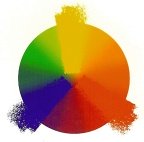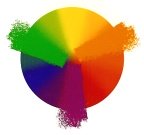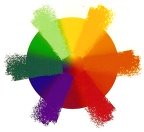Paint Color Mixing Chart
A paint color mixing chart offers a great way to learn how different paint colors are created and how they relate to one another.
A basic paint color mixing chart, or a paint color wheel, is comprised of 12 pure colors. The colors are organized in a way that shows you how they were derived.
Primary paint colors

Red, blue and yellow are called primary colors.
Unlike secondary, tertiary and quaternary colors, primary paint colors cannot be "made" by mixing.
These 3 colors give origin to the rest of the colors you see on the color wheel.
Secondary paint colors
There are also 3 secondary paint colors on a color wheel. They are created when you combine 2 primary colors together in equal amounts.

red + blue = violet
blue + yellow = green
yellow + red = orange
Notice how the secondary colors are positioned on the paint color mixing chart - right between the 3 primary colors.
Intermediate paint colors
The remaining 6 colors you see on a typical color wheel are called intermediate paint colors. They are produced by mixing a primary color with an adjacent secondary color.

yellow + orange = yellow-orange
orange + red = red-orange
red + violet = violet-red
violet + blue = blue-violet
blue + green = green-blue
green + yellow = yellow-green
On a paint color wheel, the intermediate colors are placed between the primary and secondary colors.
Tertiary paint colors
The third level of mixing paint colors produces tertiary colors. They are formed when 2 secondary colors are combined. For example:
green + orange = brown
orange + violet = brick
violet + green = slate
Tertiary colors are usually not displayed on a basic paint color mixing chart, to keep things simple.
Quaternary paint colors
There is a fourth level of mixing paint colors, which is also not shown on a regular color wheel. When 2 tertiary colors are mixed, quaternary paint colors are formed. These colors are the most complex and interesting of all - they add depth and sophistication to paint color schemes.
Whew, 4 levels deep and we are still not done with deriving paint colors! To learn how to create tints, shades, tones and vary the value and intensity of colors, continue to "The ABC's of Mixing Paint Colors".









Leave a Comment: